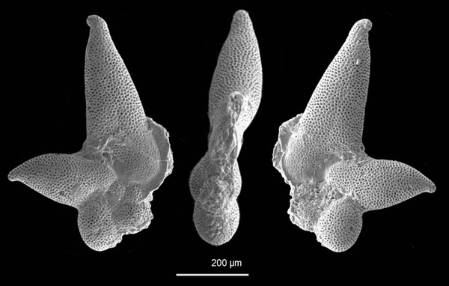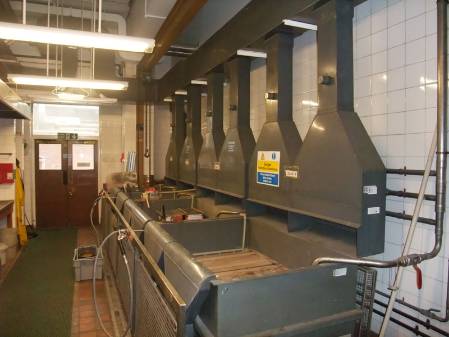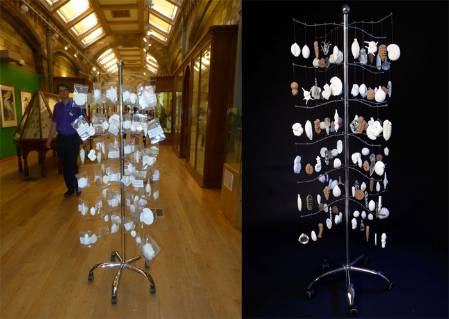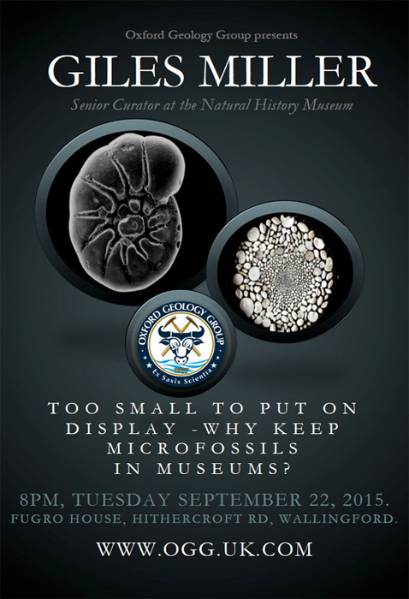This week I 'claim an assist' at the start of the football season, visit the lab where David Attenborough once dropped his camera into a vat of acid, move a microfossil tree across the Museum, am reminded how difficult it is to place a monetary value on microfossils and manage to retrieve an important file in preparation for a talk to a local society.
Monday
In footballing terms you'd call this 'claiming an assist'. In 1995 I wrote an article in the Palaeontological Association Newsletter advertising the Former BP Microfossil Collection that I was curating at the time. This alerted Prof. Paul Pearson to our collections, he arranged a visit and found some exceptionally preserved material.
His subsequent drilling projects at the same sites in Tanzania have provided some amazing material, both foraminiferal and nannofossil that have made a major contribution to the science of micropalaeontology and have been the basis for the careers of several young researchers making their way in academia.
The holotype specimen of Hantkenina singanoae. Coxall & Pearson, 2006.
Today I am registering some type material Prof. Pearson donated us from his Tanzania work. These type specimens have been published in three key papers in 2004, 2006 and 2014 but the material is currently part of our backlog for computer registration. Most journals require published material to be deposited in museum collections and this remains one of our key methods for collections development.
News of a backlog should not put off potential donors to our collection though. Pretty much every museum has a backlog and it is my priority to register this material, particularly if it has been published. I'd argue that it is better to be in this backlog, safely housed in the Museum and available for study than to be hidden in a drawer in a university office.
Tuesday
This morning I am alerted to a new paper on Research Gate, which is a kind of Facebook-for-academics highlighting the latest work by your peers. This 2014 paper provides new evidence that shows the main conclusion of my 1993 thesis is no longer valid.
My job allows me 10 percent of my time to carry out research projects and today this takes me to the acid lab in the basement to dissolve microscopic teeth called conodonts from Permian limestones from Oman. The aim is to provide dates for other studies where new trilobites and other macrofossils have been found.
The acid laboratory at the Museum. My 3kg limestone samples are in the second bay along in small boxes like the one on the floor to the left.
The laboratory is designed for preparing large vertebrate specimens by dissolving them in acetic acid (vinegar) and was most famously used by David Attenborough in his programme Life on Earth. During the filming of a time lapse series of pictures showing one of these dissolution experiments, Sir David apparently dropped his camera into the vat of acid.
Wednesday
Our Zheng Shouyi microfossil tree is to be photographed in the photo unit today so first thing I place the hanging microfossil models in plastic bags to prevent them from bashing into each other as the tree is wheeled through the gallery. It takes 15 minutes to move a short 20m distance through the Bird Gallery because members of staff on their way into work keep stopping me and asking about it.
The Zheng Shouyi microfossil tree, complete with plastic bags to prevent damage during transit (left) on its way through the Bird Gallery and (right) after its photoshoot.
When I get to the photo unit, photographer Kevin Webb is surprised because he had been told it was a fossil tree and was expecting some fossil wood! I bump into another member of staff who says they have heard about the tree at a Science Uncovered briefing but didn't realise it wasn't a real tree either, so I send some of Kevin's photographs to them for distribution.
Thursday
As I can't wheel the tree back through the gallery during opening hours I have to collect it early the next day. It takes even longer to get back through the Bird Gallery as there is a considerable amount of interest in the tree. This bodes well for our desk on the Climate Change Station at the forthcoming Science Uncovered Event on 26th September when I will be joined by my colleagues underneath the cocoon of the new Darwin Centre.
More about Science Uncovered 2014
The rest of the day is spent dealing with two loan requests, firstly for long term visitor Yukun Shi who has requested some of our larger benthic foraminifera for CT scanning. Another loan involves some specimens I computer-registered in 1994 but requires some thought as we are required to put a valuation on any material we send out on loan. It reminds me how difficult it is to value microfossil specimens when there is little commercial market for them.
Friday
An email today reminds me that a little over a year ago I agreed to give an evening talk to the Harrow and Hillingdon Geological Society. Over the last few years I've given similar talks at St Albans, Horsham and Hertford. I look for the powerpoint file for the talk that had been prepared for another venue but the folder on my hard drive has corrupted, as has the folder on my back-up hard drive. After a few moments of panic I find another copy of the file on the pen drive that I'd used when I last gave the talk.
An Oxford Geology Group advert for a talk I recently agreed to provide in 2015.
My colleague and fellow NaturePlus blogger Dr Erica McAllister is asked to give talks like these all the time. A few months ago I asked her if she ever gets choosy and says no? She said she always says yes if she can, in fact on one day she once gave three! If you have some spare moments then why not check out Erica's blog or read my colleague Mark Graham's guest post where he describes hosting a recent visit from Sir David Attenborough including a trip to the acid lab.






